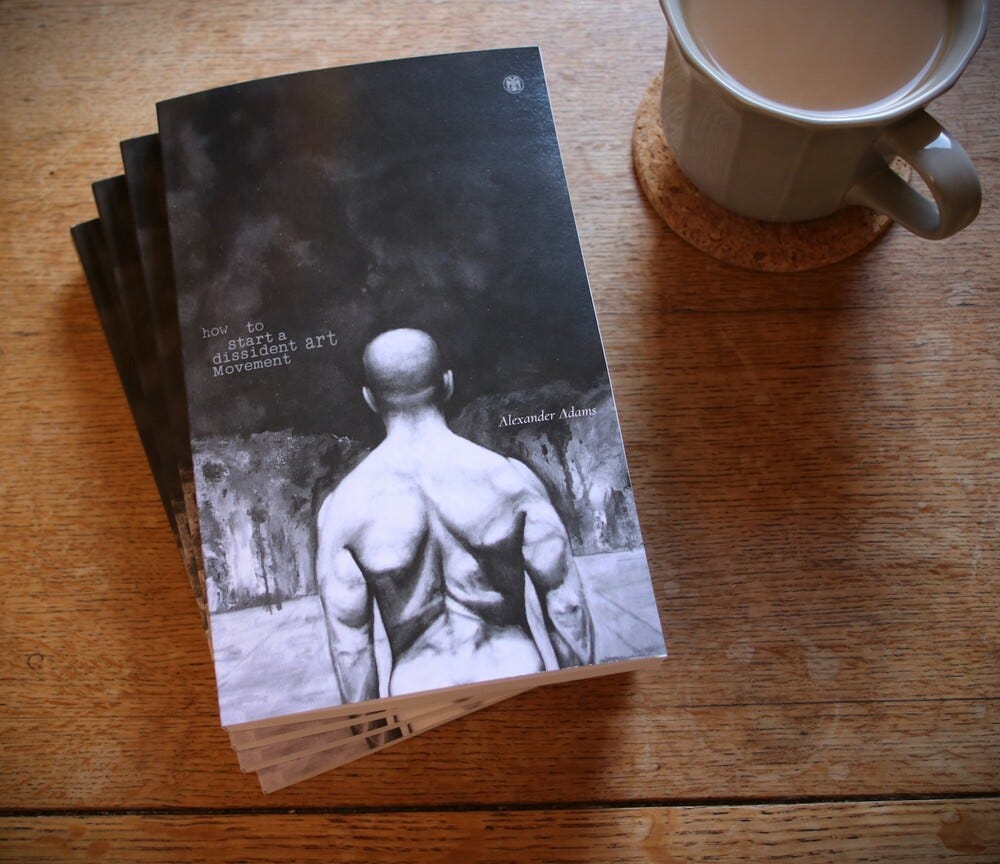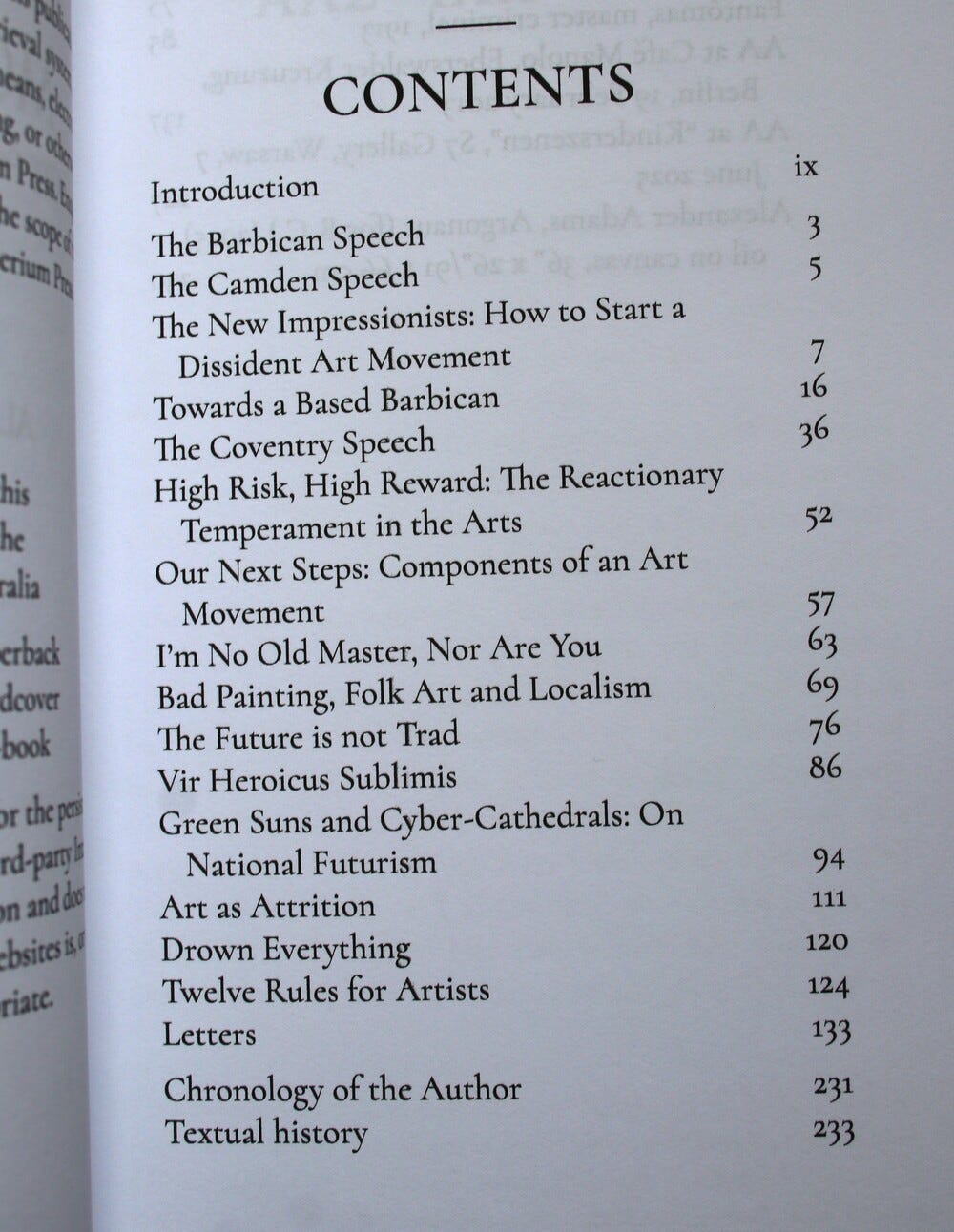Introducing “How to Start a Dissident Art Movement”
My new book allowed me to step over the culture wars and address the future
With pleasure and trepidation, I introduce you to my new book How to Start a Dissident Art Movement. As part of the re-thinking of the core principles I need to honour, I made a decisive break when I composed this book. I decided to move away from the disembodied advocacy of previous books and reviews, towards something that admitted I was in the art world about which I was writing. Having recently acknowledged that the neutrality of detached commentary was delusion and a means of concealing one’s group and self-interests, omitting the fact that art has an intrinsic partiality – utility as a means of advancing one’s values – it was not sustainable. A new book had to admit my discussions from quasi-neutral stance were not viable.
I have skin in the game and (if you care about Western culture) you do too. Let’s not pretend that this is not something on our minds and something that weighs on our hearts as we see another beloved institution erase part of its (and our) history, mock the masters and deplete its authority. It matters because if it did not, European high culture would have been so revered and carefully preserved and (consequently) so precisely targeted for subversion and usurpation by its opponents. I had treated opposing erosion of high culture as a matter of preference; now I was clear it was a matter civilisational survival. The stages were incalculably high.
In a new book I wanted to step over journalism and the sort of cultural analysis. I did not want to yet again complain about our social ailments and institutional decline. We have read so much commentary on that already that to put out another book (or article) decrying our situation would be an amplification of pessimism, amounting to assisting in a campaign of demoralisation. It is incumbent on anyone serious about the topic – after duly having established the nature of our crisis – to thereafter step over the culture wars and work towards presenting a counsel of hope not despair.
Why have so few of us historical centrists (holding views and values commonplace until a century ago) done so? Firstly, criticising is easy, especially as there is so much to justly criticise. The targets are unavoidably large and important; the causes of degradation are not difficult to identify. Secondly, offering a positive vision is often divisive. The historical centrists can easily unite against the sectarian interests of non-Europeans, the trojan horses of liberalism and the bio-Leninism of the progressivist managerial technocracy, yet when one says what one does want, their arguments start. Must the future of the arts be a form of traditionalism? If so, should it be traditionalism-in-spirit (perennial traditionalism) or a literal revival of the imagery and morality of chivalric medievalism (a sort of retvrn-to-tradition Arts & Crafts)? Suddenly, the solidarity that unites dissidents when they face the grotesque artivism and tokenism animating the corpse of state-funded fine arts evaporates as artists start promoting their preferred art style and aesthetic ethos.
Yet we have to have these conversations. I chose as a title How to Start a Dissident Art Movement because it was absurd and provocative but also aspirational and exhilarating. I wanted it to be a title that reflected accurately a book that supporters would be passionate about – the sort of book they’d thrust into the hands of artist-colleagues – and one that would also enrage sceptics, liberalists and traditionalists. The mere title alone should divide a room. I wanted sceptics to get the book in order to shred it with their own polemics only to find at least some parts of my arguments unassailable, gratingly obdurate, and to leave them thoughtfully unsettled. Whether the book does that, only you can judge.
In the book I debunk the idea that localism is any refuge, at least in the short term. I propose Modernism and vitalism as vigorous routes for future art. I look at the strengths and weaknesses of the British and American variants of National Futurism. Rather than a movement or school with a unified style or aesthetics, National Futurism looks to be shaping up as a platform. Alongside pieces you may have seen on my Substack (albeit expanded and lightly revised in the book), there are essays that are unpublished and designed to link with the previous topics. In “Twelve Rules for Artists” I give short pieces of advice that (if followed) help to make artists better, although they may not make the life of the artist easier. Too often, taking the easier route leads to compromise and failure, as I have found out to my cost. The rules are the sort of recommendations I wished I had had when I was a student. I may well have received some such advice from others when I was younger, only for me to forget it. Well, here is my reformulation.
At the end of the book, there are personal letters and postcards written by me on the subject of art and about being an artist. They show the origins of my ideas and how the approaches I have described in essays have played out in practice. In casual language I make points more forcefully or apply my ideas in encounters with exhibitions or artists. If art discussion is committed and subjective, then there is no reason not to engage in the sort of non-formal approach to art found in letters selected from the last 15 years. The selection also gives a glimpse of how artists talk to each other. It is the style of conversation I have overheard at opening nights and in the studio.
How to Start a Dissident Art Movement is a book that says goodbye to the last vestiges of liberalism in my public writing. No longer is there the hope (or desire) to return to the status quo of the 1990s; gone is the hope that restraint, reason or appeal to the aesthetic critical faculties will change the minds of those intent on undermining the achievements of the great figures of the past; banished is the dream of reconciliation – that form of grudging piecemeal surrender to the implacable opponent who gives nothing in return – and in its place arises a tough resolution. My intention is to move away from culture war discussion entirely; the essays in the book put a full-stop on topics I have previously covered (public statuary, iconoclasm, the failures of liberalism, tradition-as-form). They may act as decisive closures for me, allowing me to pursue new routes.
I wonder what readers will make of my most forthright and yet also most personal book. If it is treated with curiosity and generosity of spirit then I could not wish for anything better.
Alexander Adams, How to Start a Dissident Art Movement, Imperium Press, PB/HB/EB, xiii + 233pp, PB $19/£15, 9 Sept. 2025. It is currently available through Imperium Press’s website exclusively: https://www.imperiumpress.org/shop/how-to-start-a-dissident-art-movement/ . It will soon be available through all other usual booksellers.



I met an incredible Australian at the Battle Of Ideas this weekend and she suggested that I follow you. I’m an artist who has been trying to document my mental breakdowns as our culture has been pulled apart. We were in a discussion on ‘What does post woke art look like’. I didn’t hear much reflection on what it would look like, but it was nice to be in a room with others who are thinking about it.
Watching you on the telly right now - how exciting to learn that you exist! What a shame I missed your exhibition